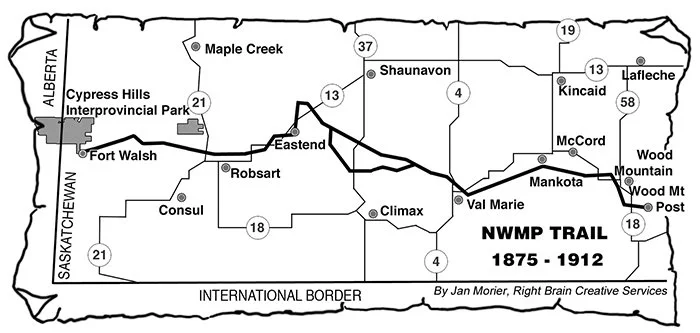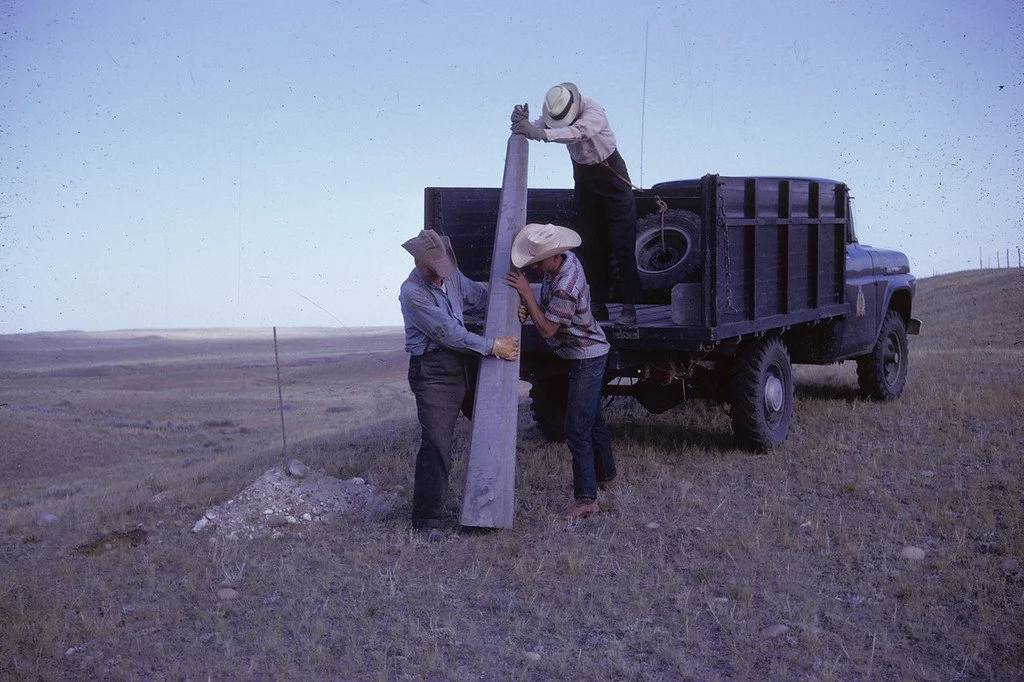Fort Walsh to Wood Mountain - North West Mounted Police Trail
“The Trail between the Cypress Hills and the Wood Mountain Uplands was, at one time, as significant as today’s Number 11 Highway between Saskatoon and Regina…[1]”
The Cypress Hills and Wood Mountain uplands have always been attractive places to live. Since time immemorial, First Nations peoples have travelled east-west between them. By the 1860s and 70s, one of these routes gained a distinct form as Red River carts of Métis traders, filled with buffalo hides, etched a path across the landscape. [2] In the 1870s, the Trail became associated with the North-West Mounted Police (NWMP), who used it to travel between their posts at Fort Walsh and Wood Mountain. [3]
“Mounted Police Trail of 1882 leading to Pinto Horse Butte. Joe Whiteford and Norm Thompson. Val Marie, 1954.” Everett Baker Slides.
Approximate route of trail (not to scale). Map courtesy of Jan Morier, Right Brain Creative Services.
1876-78 was a time of intensive use of the Trail. An estimated 5,000 Lakota and Dakota Sioux, including Lakota Chief Tȟatȟáŋka Íyotȟake (Sitting Bull), sought refuge at Wood Mountain after annihilating part of the United States Army at the Battle of the Little Big Horn. [4] Sitting Bull and James Walsh, commander of the NWMP in the Cypress Hills region, developed a relationship of mutual respect. [5]
The NWMP stopped patrolling in 1912, but the Trail was not forgotten. [6] “…older people still remembered the Trail in the stories they told. So, when Everett Baker [the SHFS’ first President] and the Saskatchewan History and Folklore Society proposed that the trail should be marked in the 1950s, there was local support…They remember it was very hard work.”[7]
Unloading NWMP Marker from Fort Walsh truck - Alex McKelvey - Reddy Parsonage & Bob Orchard. Consul, 1961.” Everett Baker Slides.”
In Everett Baker’s words:
“We hope people, 800 to 1000 years from now, will say: ‘here was the southern most thorofare of the early trails across the Western Canadian plains…’ You can see the way they skirted hills and sloughs and chose the most gradual slopes for the toiling oxen and ponies. Here, off the trail, you could be lost in the endless grass that extended beyond the horizon.”[8]
Want to see the Trail for yourself? Check out this list of Trail markers accessible to the public.
1. Fedyk, Mike. ‘History, Memory, and the NWMP Trail.’ In: Fort Walsh to Wood Mountain: the North-West Mounted Police Trail, 1-14. Mike Fedyk, ed.
2. Ibid.
3. Ibid.
4. Poirer, Thelma. ‘Wood Mountain and the Trail.’ In: Fort Walsh to Wood Mountain: the North-West Mounted Police Trail, 43-49. Mike Fedyk, ed.
5. Porter, Brian. ‘James Walsh of the North-West Mounted Police.’ In: Fort Walsh to Wood Mountain: the North-West Mounted Police Trail, 26-36. Mike Fedyk, ed.
6. Fedyk, Mike. Ibid.
7. Wilson, Audrey J. ‘The people of McCord and Mankota and the Trail.’ In: Fort Walsh to Wood Mountain: the North-West Mounted Police Trail, 50-56. Mike Fedyk, ed.
8. Baker, Everett. ‘There’s a long, long trail a-winding.’ In: Fort Walsh to Wood Mountain: the North-West Mounted Police Trail, 84-89. Mike Fedyk, ed.



